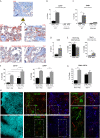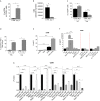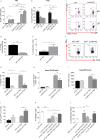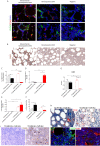CD40 Activity on Mesenchymal Cells Negatively Regulates OX40L to Maintain Bone Marrow Immune Homeostasis Under Stress Conditions
- PMID: 34084166
- PMCID: PMC8168593
- DOI: 10.3389/fimmu.2021.662048
CD40 Activity on Mesenchymal Cells Negatively Regulates OX40L to Maintain Bone Marrow Immune Homeostasis Under Stress Conditions
Abstract
Background: Within the bone marrow (BM), mature T cells are maintained under homeostatic conditions to facilitate proper hematopoietic development. This homeostasis depends upon a peculiar elevated frequency of regulatory T cells (Tregs) and immune regulatory activities from BM-mesenchymal stem cells (BM-MSCs). In response to BM transplantation (BMT), the conditioning regimen exposes the BM to a dramatic induction of inflammatory cytokines and causes an unbalanced T-effector (Teff) and Treg ratio. This imbalance negatively impacts hematopoiesis, particularly in regard to B-cell lymphopoiesis that requires an intact cross-talk between BM-MSCs and Tregs. The mechanisms underlying the ability of BM-MSCs to restore Treg homeostasis and proper B-cell development are currently unknown.
Methods: We studied the role of host radio-resistant cell-derived CD40 in restoring Teff/Treg homeostasis and proper B-cell development in a murine model of BMT. We characterized the host cellular source of CD40 and performed radiation chimera analyses by transplanting WT or Cd40-KO with WT BM in the presence of T-reg and co-infusing WT or - Cd40-KO BM-MSCs. Residual host and donor T cell expansion and activation (cytokine production) and also the expression of Treg fitness markers and conversion to Th17 were analyzed. The presence of Cd40+ BM-MSCs was analyzed in a human setting in correlation with the frequency of B-cell precursors in patients who underwent HSCT and variably developed acute graft-versus-host (aGVDH) disease.
Results: CD40 expression is nearly undetectable in the BM, yet a Cd40-KO recipient of WT donor chimera exhibited impaired B-cell lymphopoiesis and Treg development. Lethal irradiation promotes CD40 and OX40L expression in radio-resistant BM-MSCs through the induction of pro-inflammatory cytokines. OX40L favors Teff expansion and activation at the expense of Tregs; however, the expression of CD40 dampens OX40L expression and restores Treg homeostasis, thus facilitating proper B-cell development. Indeed, in contrast to dendritic cells in secondary lymphoid organs that require CD40 triggers to express OX40L, BM-MSCs require CD40 to inhibit OX40L expression.
Conclusions: CD40+ BM-MSCs are immune regulatory elements within BM. Loss of CD40 results in uncontrolled T cell activation due to a reduced number of Tregs, and B-cell development is consequently impaired. GVHD provides an example of how a loss of CD40+ BM-MSCs and a reduction in B-cell precursors may occur in a human setting.
Keywords: B-cell development; CD40; OX40L; bone marrow transplantation; mesenchymal cell.
Copyright © 2021 Bassani, Tripodo, Portararo, Gulino, Botti, Chiodoni, Jachetti, Bolli, Ciciarello, Joehrens, Anagnostopoulos, Na, Curti, Colombo and Sangaletti.
Conflict of interest statement
The authors declare that the research was conducted in the absence of any commercial or financial relationships that could be construed as a potential conflict of interest.
Figures







Similar articles
-
Therapeutic administration of bone marrow-derived mesenchymal stromal cells reduces airway inflammation without up-regulating Tregs in experimental asthma.Clin Exp Allergy. 2018 Feb;48(2):205-216. doi: 10.1111/cea.13048. Epub 2017 Dec 15. Clin Exp Allergy. 2018. PMID: 29068567
-
Immune impairments in multiple myeloma bone marrow mesenchymal stromal cells.Cancer Immunol Immunother. 2015 Feb;64(2):213-24. doi: 10.1007/s00262-014-1623-y. Epub 2014 Oct 24. Cancer Immunol Immunother. 2015. PMID: 25341809 Free PMC article.
-
Chimerism of bone marrow mesenchymal stem/stromal cells in allogeneic hematopoietic cell transplantation: is it clinically relevant?Chimerism. 2013 Jul-Sep;4(3):78-83. doi: 10.4161/chim.25609. Epub 2013 Jul 11. Chimerism. 2013. PMID: 23880502 Free PMC article. Review.
-
Combination cell therapy using mesenchymal stem cells and regulatory T-cells provides a synergistic immunomodulatory effect associated with reciprocal regulation of TH1/TH2 and th17/treg cells in a murine acute graft-versus-host disease model.Cell Transplant. 2014 Apr;23(6):703-14. doi: 10.3727/096368913X664577. Epub 2013 Feb 26. Cell Transplant. 2014. PMID: 23452894
-
Mesenchymal stem cell effects on T-cell effector pathways.Stem Cell Res Ther. 2011 Aug 11;2(4):34. doi: 10.1186/scrt75. Stem Cell Res Ther. 2011. PMID: 21861858 Free PMC article. Review.
Cited by
-
Mechanism and application of mesenchymal stem cells and their secreting extracellular vesicles in regulating CD4+T cells in immune diseases.Biophys Rep. 2024 Dec 31;10(6):403-415. doi: 10.52601/bpr.2024.240005. Biophys Rep. 2024. PMID: 39758422 Free PMC article.
-
Adipose mesenchymal stem cell-derived soluble factors, produced under hypoxic condition, efficiently support in vivo angiogenesis.Cell Death Discov. 2023 May 23;9(1):174. doi: 10.1038/s41420-023-01464-4. Cell Death Discov. 2023. PMID: 37221171 Free PMC article.
-
Immunomodulatory Effects of Primed Tonsil-Derived Mesenchymal Stem Cells on Atopic Dermatitis via B Cell Regulation.Cells. 2023 Dec 30;13(1):80. doi: 10.3390/cells13010080. Cells. 2023. PMID: 38201284 Free PMC article.
-
Hematopoietic Dysfunction during Graft-Versus-Host Disease: A Self-Destructive Process?Cells. 2021 Aug 10;10(8):2051. doi: 10.3390/cells10082051. Cells. 2021. PMID: 34440819 Free PMC article. Review.
-
Dental pulp mesenchymal stem cell (DPSCs)-derived soluble factors, produced under hypoxic conditions, support angiogenesis via endothelial cell activation and generation of M2-like macrophages.J Biomed Sci. 2024 Nov 4;31(1):99. doi: 10.1186/s12929-024-01087-6. J Biomed Sci. 2024. PMID: 39491013 Free PMC article.
References
Publication types
MeSH terms
Substances
LinkOut - more resources
Full Text Sources
Medical
Molecular Biology Databases
Research Materials

